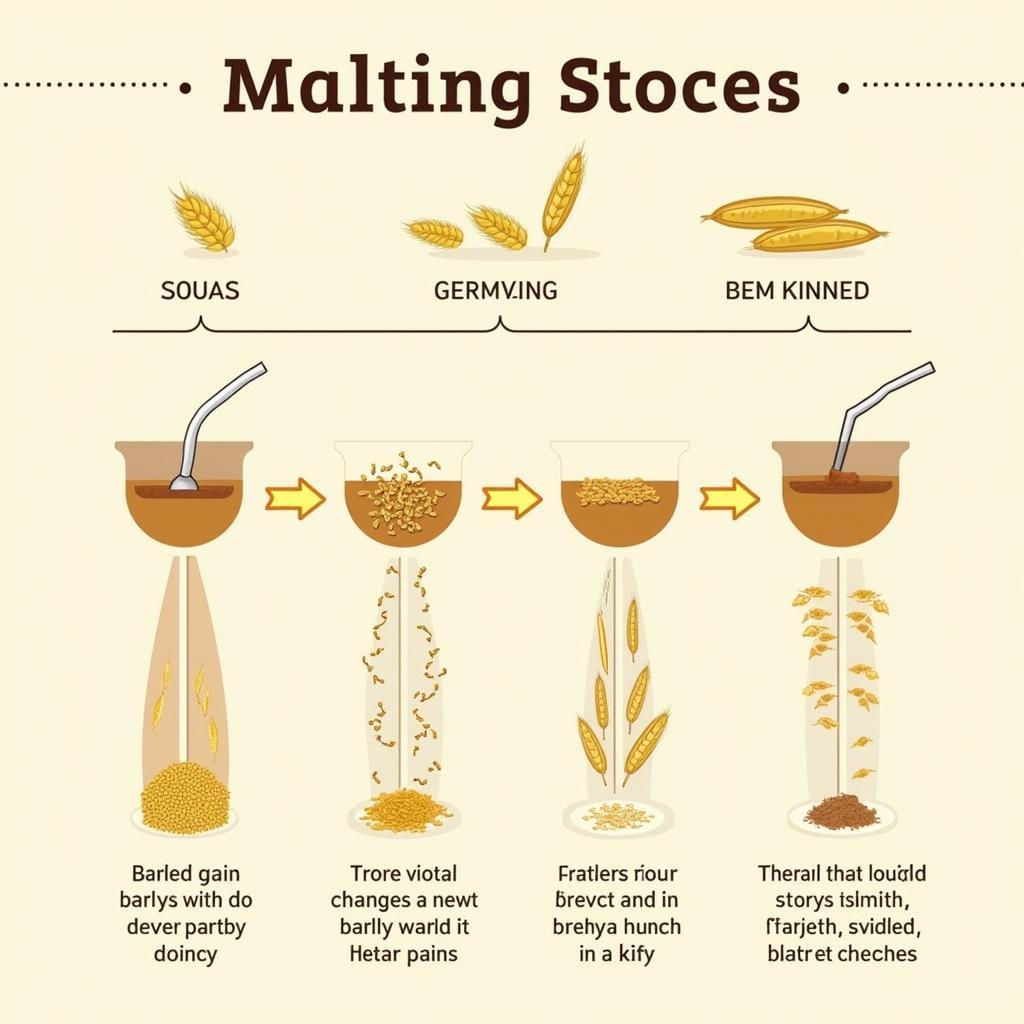Malty Foods offer a unique depth of flavor that’s both comforting and intriguing. From the subtle sweetness of malted milk powder to the rich, toasted notes in a dark beer, the malty flavor profile adds a distinct character to a wide range of culinary creations. Let’s dive into the world of malty foods and discover what makes them so special.
What Gives Malty Foods Their Distinctive Flavor?
The characteristic flavor of malty foods comes from the malting process, typically applied to grains like barley, wheat, or rye. This process involves germinating the grain, then halting the germination by drying and kilning. During germination, enzymes break down complex starches into simpler sugars, creating the sweetness associated with malty flavors. The kilning process, using heat, then develops the characteristic toasted, nutty, and sometimes even chocolatey notes that we associate with “malt.” These flavors can range from light and delicate to intensely rich and robust, depending on the grain used and the specific malting conditions.
 Malting Process of Barley
Malting Process of Barley
Malty Foods Beyond Beverages: A Culinary Adventure
While many people associate malt primarily with beverages like beer and milkshakes, its culinary applications extend far beyond drinks. Malted milk powder, for example, adds a creamy texture and a distinctive sweetness to baked goods, candies, and even savory dishes. Malted flour, made from malted barley or wheat, contributes a unique depth of flavor and improved browning to bread and other baked items. Think of the satisfyingly chewy crust of a pretzel – that’s the magic of malt at work!
From breakfast to dessert, malty flavors can enhance a wide variety of dishes. Imagine waking up to a warm bowl of malted oatmeal, topped with fresh fruit and a drizzle of honey. Or perhaps indulging in a malted chocolate cake with a scoop of vanilla ice cream for a truly decadent treat. Even savory dishes can benefit from a touch of malt – a sprinkle of malted barley flour can add a nuanced complexity to stews and sauces.
What are some common Malty Foods?
Malty flavors are surprisingly versatile, popping up in a wide range of food and drink. Here are a few popular examples:
- Beer: Perhaps the most well-known malty beverage, beer relies on malted barley for its flavor foundation, ranging from light and crisp lagers to rich and complex stouts.
- Milkshakes: The addition of malted milk powder elevates a simple milkshake to a creamy, dreamy indulgence.
- Whoppers: These iconic malted milk balls offer a satisfying crunch and a burst of sweet malty flavor.
- Bagels and Pretzels: The characteristic chewy texture and deep brown color of these baked goods are a direct result of using malted flour.
Why do people enjoy Malty Foods?
Many people find the flavor of malt comforting and nostalgic, perhaps due to its association with childhood treats like milkshakes and Whoppers. The complex interplay of sweetness, nuttiness, and toasted notes offers a depth of flavor that is both satisfying and intriguing. Furthermore, the versatility of malt allows it to complement a wide range of other ingredients, making it a welcome addition to both sweet and savory dishes.
Malted Grain Recipes to Try at Home
Interested in experimenting with malty flavors in your own kitchen? Try incorporating malted milk powder into your next batch of cookies or brownies for an extra touch of sweetness and depth. Or, explore the world of bread baking with malted flour, which will give your loaves a beautifully browned crust and a unique flavor profile. You can even try making your own malted milk at home by blending malted milk powder with milk and a touch of sweetener. The possibilities are endless!
Conclusion
Malty foods offer a delicious and versatile way to enhance your culinary experiences. From the subtle sweetness of malted milk powder to the robust flavors found in dark beer, the world of malt is ripe for exploration. So, whether you’re a seasoned foodie or just starting your culinary journey, be sure to give malty foods a try and discover the unique depth of flavor they bring to the table. Try pairing malty foods with chinese food and beer for a truly unique experience.
FAQ
- What is the malting process?
- What are the different types of malted grains?
- How is malted milk powder made?
- Can I make malted milk at home?
- What are some common uses for malted flour in baking?
- Where can I buy malted milk powder and malted flour?
- Are there any health benefits associated with consuming malted grains?
Common Scenarios with Malty Foods
- Pairing beer with food: Choosing the right malty beer to complement a meal can elevate the dining experience.
- Baking with malt: Using malted flour or malted milk powder in baking can add depth and complexity to the flavor of baked goods.
- Making homemade malted milk: Creating your own malted milk allows you to control the sweetness and thickness.
Suggested Further Reading
- Explore the nuances of chinese food and beer.
For further assistance, please contact us at Phone: 02437655121, Email: minacones@gmail.com or visit our address: 3PGH+8R9, ĐT70A, thôn Trung, Bắc Từ Liêm, Hà Nội, Việt Nam. We have a 24/7 customer service team available to help you.